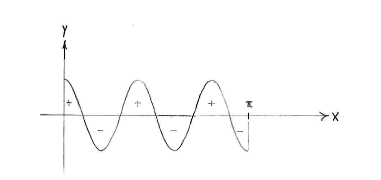Lösung 2.2:2a
Aus Online Mathematik Brückenkurs 2
K |
|||
| Zeile 1: | Zeile 1: | ||
| - | The integral is a standard integral, with | + | The integral is a standard integral, with <math>5x</math> as the argument of the cosine function. If we therefore substitute <math>u=5x</math>, we obtain the “correct” argument of the cosine, |
| - | <math> | + | |
| - | as the argument of the cosine function. If we therefore substitute | + | |
| - | <math>u= | + | |
| + | {{Displayed math||<math>\int\limits_0^{\pi} \cos 5x\,dx = \left\{\begin{align} | ||
| + | u &= 5x\\[5pt] | ||
| + | du &= (5x)'\,dx = 5\,dx | ||
| + | \end{align}\right\} = \frac{1}{5}\int\limits_0^{5\pi} \cos u\,du\,\textrm{.}</math>}} | ||
| - | <math>\ | + | As can be seen, the variable change replaced <math>dx</math> by <math>\tfrac{1}{5}\,du</math> and the new limits of integration become <math>u=5\cdot 0=0</math> |
| - | + | and <math>u=5\cdot \pi = 5\pi\,</math>. | |
| - | u= | + | |
| - | + | ||
| - | + | ||
| - | + | ||
| - | + | ||
| - | + | Now, we have a standard integral which we can easily compute, | |
| - | + | ||
| - | + | ||
| - | + | ||
| - | + | ||
| - | + | ||
| - | + | ||
| - | + | ||
| - | + | {{Displayed math||<math>\frac{1}{5}\int\limits_0^{5\pi} \cos u\,du = \frac{1}{5}\Bigl[\ \sin u\ \Bigr]_0^{5\pi} = \frac{1}{5}( \sin 5\pi -\sin 0) = \frac{1}{5}(0-0) = 0\,\textrm{.}</math>}} | |
| - | + | Note: If we draw the graph of <math>y=\cos 5x</math>, we see also that the area between the curve and ''x''-axis above the ''x''-axis is the same as the area under the ''x''-axis. | |
| - | + | ||
| - | + | ||
| - | + | ||
| - | + | ||
| - | + | ||
| - | + | ||
| - | <math>y=\cos 5x</math>, we see also that the area between the curve and | + | |
| - | + | ||
| - | -axis above the | + | |
| - | + | ||
| - | -axis is the same as the area under the | + | |
| - | + | ||
| - | -axis. | + | |
| - | + | ||
[[Image:2_2_2_a.gif|center]] | [[Image:2_2_2_a.gif|center]] | ||
Version vom 12:57, 28. Okt. 2008
The integral is a standard integral, with \displaystyle 5x as the argument of the cosine function. If we therefore substitute \displaystyle u=5x, we obtain the “correct” argument of the cosine,
| \displaystyle \int\limits_0^{\pi} \cos 5x\,dx = \left\{\begin{align}
u &= 5x\\[5pt] du &= (5x)'\,dx = 5\,dx \end{align}\right\} = \frac{1}{5}\int\limits_0^{5\pi} \cos u\,du\,\textrm{.} |
As can be seen, the variable change replaced \displaystyle dx by \displaystyle \tfrac{1}{5}\,du and the new limits of integration become \displaystyle u=5\cdot 0=0 and \displaystyle u=5\cdot \pi = 5\pi\,.
Now, we have a standard integral which we can easily compute,
| \displaystyle \frac{1}{5}\int\limits_0^{5\pi} \cos u\,du = \frac{1}{5}\Bigl[\ \sin u\ \Bigr]_0^{5\pi} = \frac{1}{5}( \sin 5\pi -\sin 0) = \frac{1}{5}(0-0) = 0\,\textrm{.} |
Note: If we draw the graph of \displaystyle y=\cos 5x, we see also that the area between the curve and x-axis above the x-axis is the same as the area under the x-axis.

